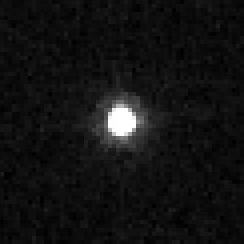 Dziewanna imaged by the Hubble Space Telescope in 2012 | |
| Discovery [1] [2] | |
|---|---|
| Discovered by | A. Udalski S. S. Sheppard M. Kubiak C. Trujillo |
| Discovery site | Las Campanas Obs. |
| Discovery date | 13 March 2010 |
| Designations | |
| (471143) Dziewanna | |
| Pronunciation | /ziːˈwɒnə/ ,[ citation needed ] Polish: [d͡ʑɛˈvanna] |
Named after | Devana (Dziewanna) (Slavic goddess) [1] |
| 2010 EK139 | |
| TNO [3] · SDO · 2:7 [4] | |
| Adjectives | Dziewannian |
| Orbital characteristics [3] | |
| Epoch 23 March 2018 (JD 2458200.5) | |
| Uncertainty parameter 3 | |
| Observation arc | 13.16 yr (4,808 d) |
| Aphelion | 108.54 AU |
| Perihelion | 32.551 AU |
| 70.544 AU | |
| Eccentricity | 0.5386 |
| 592.51 yr (216,416 d) | |
| 347.58° | |
| 0° 0m 6.12s / day | |
| Inclination | 29.444° |
| 346.15° | |
| ≈ 22 October 2038 [5] ±1 days | |
| 284.25° | |
| Known satellites | 0 [6] |
| Physical characteristics | |
| >504 km (occultation) [7] 470+35 −10 km [6] 697 km [8] | |
| 7.07±0.05 [9] | |
| 0.10 (assumed) [8] 0.25+0.02 −0.05 [6] | |
| 19.6 (R) [4] 19.9 [10] | |
| 3.8±0.1 [6] 3.89±0.04(S) [9] 3.9 [1] [3] | |
471143 Dziewanna (provisional designation 2010 EK139) is a trans-Neptunian object in the scattered disc, orbiting the Sun in the outermost region of the Solar System.
Contents
Dziewanna was discovered on 13 March 2010 by astronomers Andrzej Udalski, Scott Sheppard, Marcin Kubiak and Chad Trujillo at the Las Campanas Observatory in Chile. [1] Based on its absolute magnitude and assumed albedo, it is estimated to have a diameter of approximately 470 kilometers. [6] On 25 September 2018, it was named after Devana (Polish form: Dziewanna), a Slavic goddess of the wilderness, forests and the hunt, [1] in honor of the fact that it was discovered during the Polish Optical Gravitational Lensing Experiment of Warsaw University, which was led by Udalski. [11]



